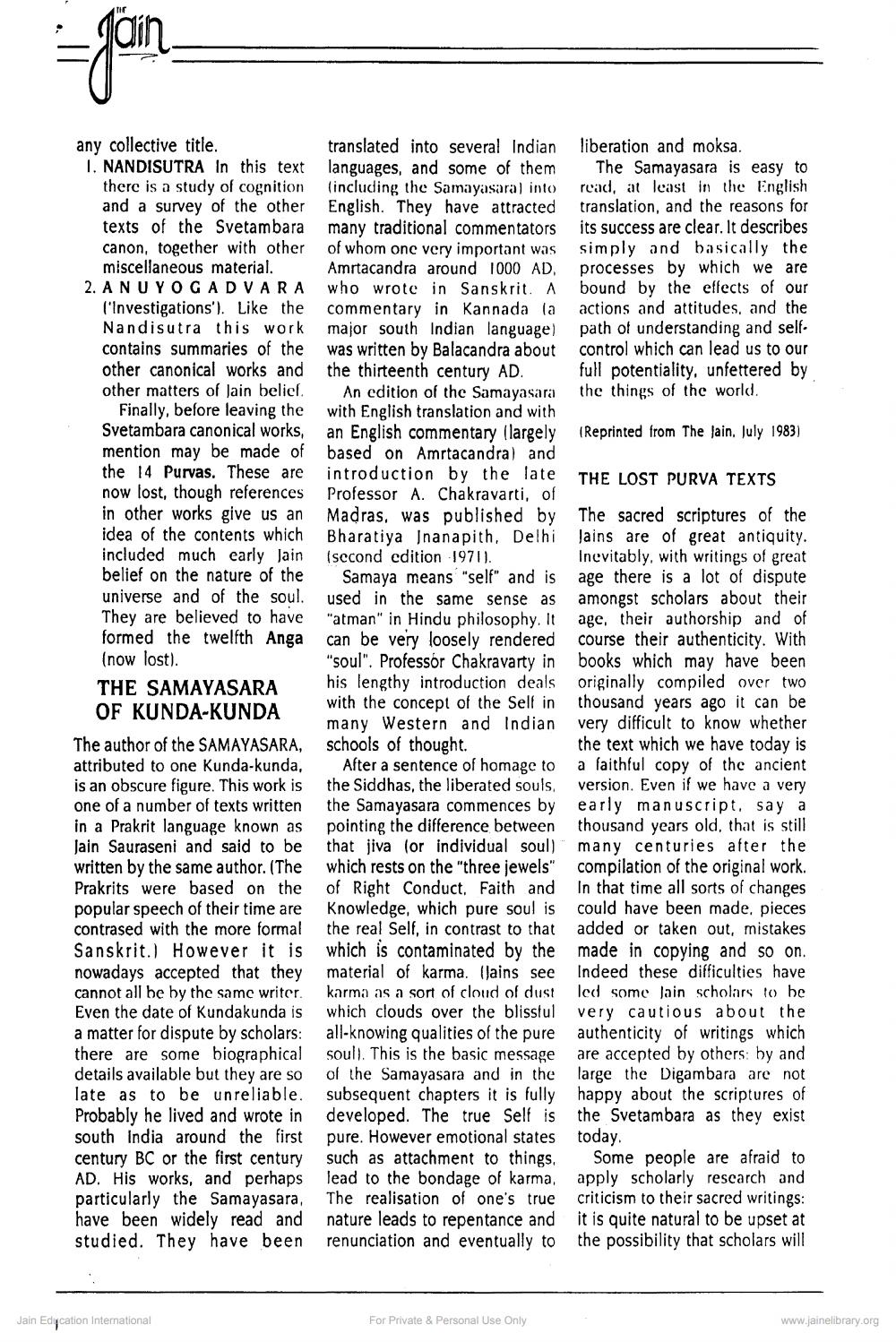Book Title: Jain Literature Author(s): Paul Marett Publisher: ZZZ Unknown View full book textPage 5
________________ :_gain any collective title. translated into several Indian liberation and moksa. I. NANDISUTRA In this text languages, and some of them The Samayasara is easy to there is a study of cognition (including the Samayasara) into read, at least in the English and a survey of the other English. They have attracted translation, and the reasons for texts of the Svetambara many traditional commentators its success are clear. It describes canon, together with other of whom one very important was simply and basically the miscellaneous material. Amrtacandra around 1000 AD. processes by which we are 2. ANUYOGAD VARA who wrote in Sanskrit. A bound by the effects of our ('Investigations'). Like the commentary in Kannada la actions and attitudes, and the Nandisutra this work major south Indian language) path of understanding and selfcontains summaries of the was written by Balacandra about control which can lead us to our other canonical works and the thirteenth century AD. full potentiality, unfettered by other matters of Jain belics. An edition of the Samayasara the things of the world. Finally, before leaving the with English translation and with Svetambara canonical works, an English commentary largely (Reprinted from The Jain. July 1983) mention may be made of based on Amrtacandral and the 14 Purvas. These are introduction by the late THE LOST PURVA TEXTS now lost, though references Professor A. Chakravarti, of in other works give us an Madras, was published by The sacred scriptures of the idea of the contents which Bharatiya Jnanapith, Delhi Jains are of great antiquity. included much early Jain (second cdition 1971). Inevitably, with writings of great belief on the nature of the Samaya means "self" and is age there is a lot of dispute universe and of the soul. used in the same sense as amongst scholars about their They are believed to have "atman" in Hindu philosophy. It age, their authorship and of formed the twelfth Anga can be very loosely rendered course their authenticity. With (now lost). "soul". Professor Chakravarty in books which may have been THE SAMAYASARA his lengthy introduction deals originally compiled over two OF KUNDA-KUNDA with the concept of the Self in thousand years ago it can be many Western and Indian very difficult to know whether The author of the SAMAYASARA, schools of thought. the text which we have today is attributed to one Kunda-kunda, After a sentence of homage to a faithful copy of the ancient is an obscure figure. This work is the Siddhas, the liberated souls, version. Even if we have a very one of a number of texts written the Samayasara commences by early manuscript, say a in a Prakrit language known as pointing the difference between thousand years old, that is still Jain Sauraseni and said to be that jiva for individual soul) many centuries after the written by the same author. (The which rests on the three jewels" compilation of the original work. Prakrits were based on the of Right Conduct. Faith and in that time all sorts of changes popular speech of their time are knowledge, which pure soul is could have been made, pieces contrased with the more formal the real Self, in contrast to that added or taken out, mistakes Sanskrit. However it is which is contaminated by the made in copying and so on. nowadays accepted that they material of karma. (Jains see Indeed these difficulties have cannot all be by the same writer. karma as a sort of cloud of dust lcd some Jain scholars to be Even the date of Kundakunda is which clouds over the blisstul very cautious about the a matter for dispute by scholars: all-knowing qualities of the pure authenticity of writings which there are some biographical soul). This is the basic message are accepted by others: by and details available but they are so of the Samayasara and in the large the Digambara are not late as to be unreliable. subsequent chapters it is fully happy about the scriptures of Probably he lived and wrote in developed. The true Self is the Svetambara as they exist south India around the first pure. However emotional states today. century BC or the first century such as attachment to things. Some people are afraid to AD. His works, and perhaps lead to the bondage of karma, apply scholarly rescarch and particularly the Samayasara, The realisation of one's true criticism to their sacred writings: have been widely read and nature leads to repentance and it is quite natural to be upset at studied. They have been renunciation and eventually to the possibility that scholars will Jain Ediycation International For Private & Personal Use Only www.jainelibrary.orgPage Navigation
1 ... 3 4 5 6 7 8 9
